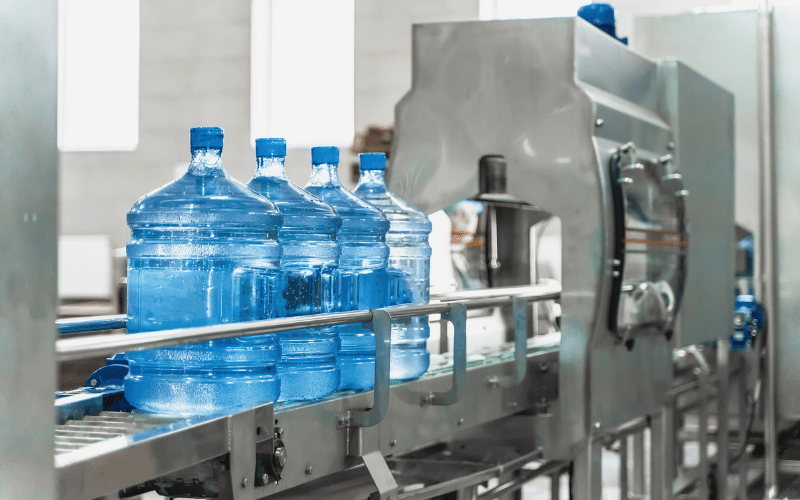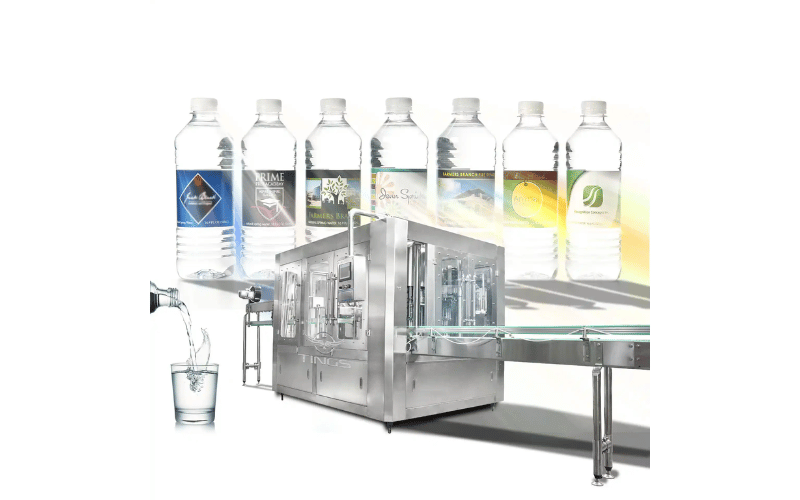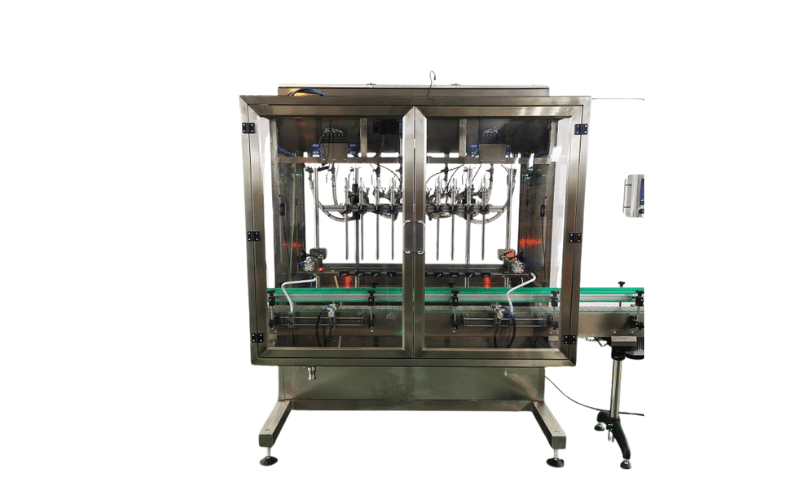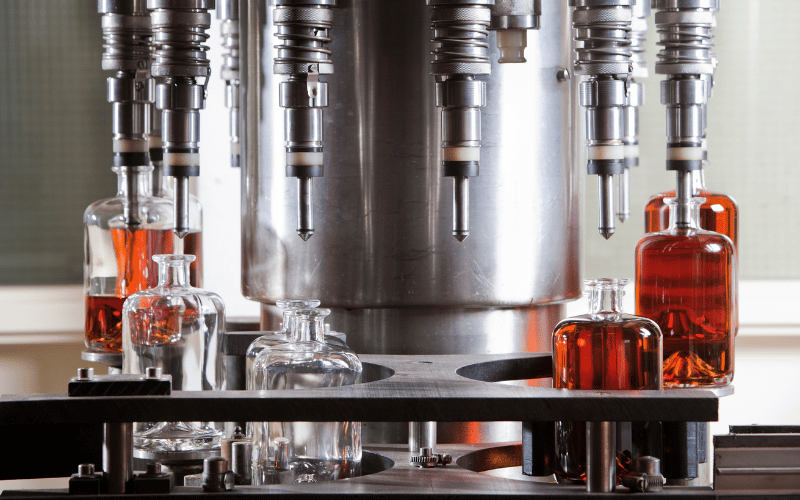تلعب تعبئة السوائل دورًا محوريًا في التصنيع، إذ تضمن تغليفًا دقيقًا وفعالًا وصحيًا للمنتجات السائلة. تُسهّل هذه العملية الإنتاج، وتقلل الهدر، وتحافظ على جودة المنتج، مما يجعلها ضرورية لمختلف الصناعات. تعتمد قطاعات مثل المشروبات والأدوية ومستحضرات التجميل والعناية الشخصية اعتمادًا كبيرًا على آلات تعبئة السوائل لتلبية الطلبات الكبيرة مع الالتزام بمعايير الجودة والسلامة الصارمة.
جدول المحتويات
تبديلما هو ملء السوائل؟
يشير ملء السوائل إلى عملية توزيع المنتجات السائلة بدقة في حاويات، مثل الزجاجات والبرطمانات والأكياس، كجزء من نظام إنتاج وتعبئة أوسع. تضمن هذه الخطوة الأساسية في التصنيع تعبئة المنتجات بكفاءة وثبات، وبما يتوافق مع معايير الصناعة. لا يقتصر دور ملء السوائل على تحسين سير العمل الإنتاجي فحسب، بل يقلل أيضًا من الهدر ويحافظ على سلامة المنتج، مما يجعله ركيزة أساسية لصناعات مثل المشروبات والأدوية ومستحضرات التجميل ومنتجات التنظيف.
العمليات الرئيسية في تعبئة السوائل
تتضمن عملية تعبئة السوائل عدة عمليات مترابطة تعمل معًا لضمان جاهزية المنتج النهائي للتوزيع. فيما يلي شرح مفصل للمراحل الرئيسية:
حشوة
مرحلة التعبئة هي جوهر عملية تعبئة السوائل، حيث يُوزّع المنتج في عبوات بدقة وسرعة. تستخدم آلات التعبئة المتطورة أساليب مختلفة بناءً على لزوجة المنتج وخصائصه. على سبيل المثال، تُناسب عملية التعبئة بالجاذبية السوائل الرقيقة غير الغازية مثل الماء أو العصير، بينما تُناسب عملية التعبئة بالمكبس المواد السميكة مثل الكريمات أو الصلصات. غالبًا ما تُستخدم عملية التعبئة بالضغط للمشروبات الغازية للحفاظ على مستوى الكربنة المناسب.
تتضمن أنظمة التعبئة الحديثة مستشعراتٍ وأنظمة تحكمٍ آلية لضمان دقة مستويات التعبئة، مما يقلل من هدر المنتج ويحافظ على اتساق جميع الحاويات. تُعد هذه الدقة بالغة الأهمية في صناعاتٍ مثل الأدوية، حيث قد تؤثر حتى الاختلافات الطفيفة على فعالية المنتج وامتثاله للأنظمة.
ختم
بعد ملء الحاويات، تضمن عملية الختم بقاء المنتج آمنًا ومحميًا من التلوث أو التسرب. تختلف طرق الختم باختلاف نوع الحاوية والمنتج. على سبيل المثال، يمكن غلق الزجاجات بأغطية لولبية، أو أغطية سريعة الفتح، أو أغطية مقاومة للعبث، بينما غالبًا ما تستخدم الأكياس الختم الحراري لإنشاء حاجز محكم.
تُطبّق آلات الختم أغطيةً بعزم أو ضغط ثابتين، مما يضمن إغلاقًا محكمًا وموثوقًا دون إتلاف العبوة. تُعد هذه الخطوة أساسية للحفاظ على جودة المنتج، وإطالة مدة صلاحيته، واستيفاء معايير السلامة. وفي صناعات مثل مستحضرات التجميل والمشروبات، يلعب الختم دورًا أيضًا في تعزيز المظهر الجمالي للمنتج وثقة المستهلك.
رقابة جودة
تُعدّ مراقبة الجودة بمثابة نقطة التفتيش النهائية في عملية تعبئة السوائل، حيث تضمن استيفاء كل عبوة للمعايير المطلوبة قبل وصولها إلى المستهلكين. تراقب أنظمة التفتيش الآلية المجهزة بكاميرات وأجهزة استشعار جوانب مختلفة من العملية، مثل مستويات التعبئة، وسلامة الختم، ووضع الملصقات. تستطيع هذه الأنظمة اكتشاف العيوب، مثل العبوات غير الممتلئة بالكامل، أو الأغطية غير المتراصة، أو العبوات التالفة، مما يؤدي إلى إزالة المنتجات المعيبة من خط الإنتاج.
بالإضافة إلى الأنظمة الآلية، تتضمن بعض العمليات فحوصات جودة يدوية للتحقق من دقة عمليات فحص الآلات. ومن خلال الحفاظ على رقابة صارمة على الجودة، يمكن للمصنعين تقديم منتجات تلبي توقعات المستهلكين وتتوافق مع المتطلبات التنظيمية، مما يحمي سمعتهم ونتائجهم المالية.
ومن خلال دمج هذه العمليات الرئيسية، تمكن أنظمة تعبئة السوائل الشركات المصنعة من إنتاج منتجات عالية الجودة وجاهزة للبيع بكفاءة وبشكل مستمر، وتلبية متطلبات الأسواق التنافسية.
أكثر 4 طرق شيوعًا لتعبئة السوائل
تختلف طرق تعبئة السوائل باختلاف نوع المنتج، ودرجة لزوجته، والمتطلبات الخاصة بعملية التعبئة. تتميز كل طريقة بمزايا فريدة، وهي مصممة خصيصًا لتلبية احتياجات مختلف الصناعات. نستعرض أدناه أكثر أربع تقنيات شيوعًا لتعبئة السوائل، مع شرح مفصل لكيفية عملها وتطبيقاتها الشائعة.
حشوة إيزوباريك
كيف يعمل: معادلة الضغط ووزن السائل
الحشو متساوي الضغط، المعروف أيضًا باسم الحشو المضاد للضغط، يستخدم معادلة الضغط لنقل السائل إلى الحاويات. تتضمن هذه الطريقة ضبط ضغط الحاوية ليتناسب مع ضغط مصدر السائل، مما يسمح للسائل بالتدفق بسلاسة دون رغوة زائدة أو فقدان للكربونات. بمجرد استقرار الضغط، يملأ السائل الحاوية إلى المستوى المطلوب، ويتم إطلاق أي غاز زائد للحفاظ على التوازن.
التطبيقات: المشروبات الغازية والسوائل التي تتطلب دخول/خروج الغاز
الحشوة متساوية الضغط مثالية للمشروبات الغازية مثل الصودا والبيرة و مياه فوارة، إذ تحافظ على عملية الكربنة أثناء عملية التعبئة. تُناسب هذه الطريقة السوائل التي تتطلب سحب أو إخراج غاز، مثل المشروبات المُشبعة بالنيتروجين. من خلال الحفاظ على اتساق الضغط، تضمن عملية التعبئة المتساوية الضغط جودة المنتج وتمنع مشاكل مثل فرط الرغوة أو نقص الكربنة.
التعبئة الجوية
كيف يعمل: وزن السائل والجاذبية
تعتمد عملية التعبئة الجوية على الجاذبية الأرضية والوزن الطبيعي للسائل لملء الحاويات. في هذه الطريقة، يتدفق السائل من الخزان إلى الحاوية عبر فوهة، حيث تتحكم الجاذبية الأرضية في معدل التدفق. تُناسب هذه الطريقة السوائل منخفضة اللزوجة التي لا تتطلب ضغطًا إضافيًا للتحرك عبر النظام.
التطبيقات: السوائل منخفضة اللزوجة مثل العصير والنبيذ والحليب
تُستخدم هذه الطريقة عادةً لمنتجات مثل العصائر والنبيذ والحليب وغيرها من المشروبات غير الغازية. بساطتها وفعاليتها من حيث التكلفة تجعلها خيارًا شائعًا للصناعات التي تتعامل مع كميات كبيرة من السوائل منخفضة اللزوجة. ومع ذلك، قد لا يكون التعبئة الجوية مناسبة للمواد السميكة أو المنتجات التي تتطلب مستويات تعبئة دقيقة.
تعبئة الضغط
كيف يعمل: الضغط الإيجابي للسوائل الأكثر سمكًا
يستخدم نظام التعبئة بالضغط ضغطًا إيجابيًا لدفع السائل إلى داخل العبوات، مما يجعله فعالًا للمنتجات الأكثر سمكًا أو لزوجة. يطبق النظام ضغطًا مُتحكمًا به لدفع السائل عبر فوهة التعبئة إلى داخل العبوة، مما يضمن تعبئةً دقيقةً ومتسقة. كما يُمكن استخدام هذه الطريقة في السوائل التي تحتاج إلى تعبئة في درجات حرارة عالية.
التطبيقات: المشروبات الساخنة، والمشروبات الكحولية، والمواد شبه السائلة
يُستخدم التعبئة بالضغط على نطاق واسع في المشروبات الساخنة كالقهوة والشاي، والمشروبات الكحولية كالمشروبات الروحية، والمنتجات شبه السائلة كالصلصات والكريمات. قدرتها على تحمل درجات حرارة ودرجات حرارة مختلفة تجعلها متعددة الاستخدامات في مختلف الصناعات. كما تضمن التعبئة بالضغط تعبئة الحاويات بسرعة وكفاءة، حتى مع المنتجات الصعبة.
تعبئة الفراغ
كيف يعمل: فرق الضغط للسوائل عالية اللزوجة
يُحدث التعبئة الفراغية فرق ضغط بين مصدر السائل والعبوة لسحب السائل إلى الزجاجة. يُزيل النظام الهواء من العبوة، مما يُنشئ فراغًا يسحب السائل إلى الداخل. تُناسب هذه الطريقة السوائل عالية اللزوجة أو المنتجات التي تتطلب أقل قدر من التعرض للهواء للحفاظ على جودتها.
التطبيقات: الشراب والسوائل الخطرة والمنتجات التي تتطلب الحد الأدنى من التعرض للهواء
تُستخدم التعبئة الفراغية عادةً للشراب والزيوت والسوائل السميكة الأخرى التي تتطلب مستويات تعبئة دقيقة. كما أنها مناسبة للسوائل الخطرة، إذ تقلل عملية التفريغ من الانسكاب والتعرض. إضافةً إلى ذلك، تُعد هذه الطريقة مثالية للمنتجات التي يجب تجنب ملامستها للهواء، مثل بعض المواد الكيميائية أو المحاليل الصيدلانية، مما يضمن سلامة المنتج وسلامته.
ومن خلال فهم طرق تعبئة السوائل الأربعة هذه، يمكن للمصنعين اختيار التقنية الأكثر ملاءمة لمنتجاتهم، مما يضمن الكفاءة والدقة والجودة طوال عملية الإنتاج.
تقنيات متقدمة في تعبئة السوائل
مع تزايد حاجة الصناعات إلى دقة وكفاءة أعلى، ظهرت تقنيات متطورة لتعبئة السوائل لتلبية متطلبات منتجات محددة. تتجاوز هذه الطرق عمليات التعبئة التقليدية، مما يوفر تحكمًا وتكيفًا معززين لتطبيقات فريدة. نستعرض أدناه تقنيتين متقدمتين - التعبئة بالتفريغ منخفض الجاذبية والتعبئة بالتفريغ الكامل - واستخداماتهما المتخصصة.
تعبئة الفراغ منخفضة الجاذبية: مثالية للنبيذ والمشروبات الكحولية
تجمع عملية التعبئة بالتفريغ منخفض الجاذبية بين مبدأي الجاذبية والفراغ لتحقيق تعبئة دقيقة وناعمة، مما يجعلها خيارًا ممتازًا للسوائل الحساسة كالنبيذ والمشروبات الكحولية. تستخدم هذه الطريقة الجاذبية لتوجيه السائل إلى داخل العبوة، بينما يزيل الفراغ المُتحكم به الهواء الزائد، مما يضمن تعبئة سلسة ومتجانسة. تقلل هذه العملية من الاضطراب، مما يُساعد على الحفاظ على جودة السائل ويمنع الرغوة أو الأكسدة.
هذه التقنية مفيدة بشكل خاص للمشروبات الكحولية، إذ تحافظ على نكهة المنتج ورائحته. بتقليل تعرضه للهواء، يمنع التعبئة الفراغية منخفضة الجاذبية الأكسدة، التي قد تؤثر على طعم النبيذ والمشروبات الروحية ومدة صلاحيتها. بالإضافة إلى ذلك، تضمن هذه الطريقة دقة مستويات التعبئة، وهو أمر بالغ الأهمية للمنتجات الفاخرة التي تتطلب الاتساق والشكل. كما أن سهولة التعامل تجعلها مناسبة للزجاجات الزجاجية الهشة، مما يقلل من خطر الكسر أثناء عملية التعبئة.
التعبئة الفراغية الكاملة: الأفضل للسوائل عالية اللزوجة والحساسة
تُحسّن عملية التعبئة الفراغية الكاملة عملية التفريغ من خلال خلق فراغ كامل داخل العبوة قبل إدخال السائل. تُعد هذه التقنية فعّالة للغاية مع المنتجات عالية اللزوجة، مثل الشراب والزيوت والكريمات، بالإضافة إلى السوائل الحساسة التي تتطلب أقل قدر من التعرض للهواء. من خلال إزالة الهواء تمامًا من العبوة، تضمن التعبئة الفراغية الكاملة تعبئة دقيقة وموحدة، حتى مع المواد السميكة أو اللزجة.
تتفوق هذه الطريقة أيضًا في التطبيقات التي تُعدّ سلامة المنتج أمرًا بالغ الأهمية. على سبيل المثال، تستفيد المحاليل الصيدلانية وبعض المواد الكيميائية من التعبئة الكاملة بالتفريغ، إذ تُزيل أي فقاعات هوائية قد تُؤثر على استقرار المنتج أو فعاليته. كما تُقلل هذه العملية من الانسكابات والنفايات، مما يجعلها حلاً اقتصاديًا للسوائل عالية القيمة. علاوة على ذلك، تضمن التعبئة الكاملة بالتفريغ إحكام إغلاق الحاويات، مما يُعزز سلامة المنتج ويطيل مدة صلاحيته.
من خلال دمج هذه التقنيات المتقدمة، يمكن للمصنعين مواجهة التحديات الفريدة المتمثلة في تعبئة السوائل الدقيقة أو عالية اللزوجة أو الحساسة. لا تُحسّن هذه الأساليب الكفاءة والدقة فحسب، بل تُساعد أيضًا في الحفاظ على جودة المنتج النهائي وسلامته، مُلبيةً بذلك متطلبات الأسواق التنافسية.
المكونات الرئيسية لآلات تعبئة السوائل
تعتمد آلات تعبئة السوائل على عدة مكونات أساسية لضمان أداء دقيق وفعال وعالي الجودة. لكل جزء دور محدد في الحفاظ على الدقة، وتقليل الهدر، وتحقيق نتائج متسقة. نستعرض أدناه المكونات الرئيسية لآلات تعبئة السوائل ووظائفها بالتفصيل.
صمامات التعبئة: الدقة والتحكم
صمامات التعبئة هي أساس أي آلة تعبئة سوائل، حيث تتحكم في تدفق السائل إلى العبوات بدقة وإتقان. تنظم هذه الصمامات كمية السائل الموزعة، مما يضمن وصول كل عبوة إلى الحجم الصحيح. غالبًا ما تتضمن صمامات التعبئة المتقدمة إعدادات قابلة للتعديل لتناسب مختلف اللزوجة السائلة، أحجام الحاويات، ومستويات التعبئة.
على سبيل المثال، تعمل صمامات التعبئة القائمة على الجاذبية بشكل جيد مع السوائل منخفضة اللزوجة كالماء أو العصير، بينما تُناسب صمامات الضغط المواد الأكثر كثافة كالشراب أو الكريمات. كما تتميز بعض الأنظمة بصمامات تعبئة متعددة الرؤوس، مما يسمح بتعبئة عدة حاويات في آنٍ واحد، مما يزيد من سرعة الإنتاج دون المساس بالدقة. ومن خلال الحفاظ على تحكم دقيق في عملية التعبئة، تُساعد هذه الصمامات على تقليل هدر المنتج وضمان اتساق جميع الحاويات.
مجمعات الفائض: تقليل النفايات
تلعب مجمعات الفائض دورًا محوريًا في تقليل النفايات والحفاظ على بيئة إنتاج نظيفة. تلتقط هذه المكونات السوائل الزائدة التي تنسكب أو تتدفق أثناء عملية التعبئة، مما يمنعها من تلويث الآلة أو المناطق المحيطة بها. غالبًا ما يمكن إعادة تدوير السائل المجمع إلى النظام، مما يقلل من هدر المنتج ويحسّن كفاءة التكلفة.
تُعد مجمعات الفائض مفيدةً بشكل خاص في العمليات عالية السرعة، حيث قد تؤدي أي اختلافات طفيفة في مستويات التعبئة إلى انسكاب السوائل. ومن خلال إدارة الفائض بفعالية، تساعد هذه الأنظمة في الحفاظ على نظافة مساحة العمل وتقليل الحاجة إلى التنظيف أو الصيانة المتكررة. كما تُسهم في جهود الاستدامة من خلال تقليل النفايات وتحسين استخدام الموارد، مما يجعلها ميزةً أساسيةً في آلات تعبئة السوائل الحديثة.
أنظمة مراقبة الجودة: ضمان الاتساق
تضمن أنظمة مراقبة الجودة استيفاء كل حاوية للمعايير المطلوبة من حيث الحجم وسلامة الختم والمظهر العام. تستخدم هذه الأنظمة تقنيات متطورة، مثل أجهزة الاستشعار والكاميرات وأدوات التفتيش الآلية، لمراقبة عملية التعبئة آنيًا. على سبيل المثال، تستطيع أجهزة الاستشعار اكتشاف الحاويات الممتلئة بشكل ناقص أو زائد، بينما تكشف الكاميرات عن مشاكل مثل عدم محاذاة الأغطية أو تلف الملصقات.
تُزيل أنظمة مراقبة الجودة الآلية الحاويات المعيبة من خط الإنتاج، مما يضمن وصول المنتجات عالية الجودة فقط إلى المستهلكين. كما توفر بعض الأنظمة بيانات وتحليلات مُفصّلة، مما يُمكّن المُشغّلين من تحديد الاتجاهات، واستكشاف الأخطاء وإصلاحها، وتحسين الأداء. ومن خلال الحفاظ على رقابة صارمة على الجودة، تُساعد هذه الأنظمة الشركات على تقديم منتجات مُتسقة وموثوقة مع تقليل الهدر وإعادة التصنيع.
ومن خلال دمج هذه المكونات الرئيسية، تحقق آلات تعبئة السوائل مستويات عالية من الدقة والكفاءة والجودة، وتلبي متطلبات الصناعات التنافسية وتضمن رضا العملاء.
كيفية اختيار طريقة تعبئة السوائل المناسبة
يُعد اختيار طريقة تعبئة السوائل الأنسب أمرًا بالغ الأهمية لتحسين كفاءة الإنتاج، والحفاظ على جودة المنتج، وتلبية الاحتياجات التشغيلية المحددة. ومع تنوع الطرق المتاحة، يتعين على الشركات تقييم عدة عوامل لضمان توافق التقنية المختارة مع خصائص منتجاتها وأهدافها الإنتاجية. نستعرض أدناه الاعتبارات الرئيسية ونقدم إرشادات حول ملاءمة طرق التعبئة لتطبيقات محددة.
العوامل التي يجب مراعاتها
لزوجة السائل
تلعب لزوجة السائل دورًا هامًا في تحديد طريقة التعبئة المناسبة. السوائل الرقيقة، كالماء والعصير والنبيذ، تتدفق بسهولة وتتطلب قوة أقل لملء العبوات. وتُعدّ طرق التعبئة الجوية أو المتساوية الضغط مناسبة لهذه المنتجات، إذ تعتمد على الجاذبية أو معادلة الضغط لنقل السائل بكفاءة.
تتطلب السوائل الأكثر كثافة، مثل الشراب والكريمات والصلصات، أنظمةً أكثر متانة للتعامل مع مقاومتها العالية للتدفق. يوفر التعبئة بالضغط أو الفراغ القوة اللازمة لنقل هذه المواد إلى الحاويات مع الحفاظ على الدقة والاتساق. يضمن فهم لزوجة منتجك أن تتمكن طريقة التعبئة من التعامل مع خصائص تدفقه الفريدة دون المساس بالكفاءة.
حجم الإنتاج وسرعته
تؤثر متطلبات حجم الإنتاج وسرعته أيضًا على اختيار طريقة التعبئة. تستفيد العمليات عالية السرعة، مثل تلك المستخدمة في تصنيع المشروبات أو الأدوية على نطاق واسع، من أنظمة آلية مثل التعبئة المتساوية الضغط أو التعبئة بالضغط، والتي يمكنها التعامل مع حاويات متعددة في آنٍ واحد. تضمن هذه الطرق إنتاجًا سريعًا دون المساس بالدقة.
بالنسبة للعمليات ذات النطاق الأصغر أو المنتجات المتخصصة، قد تكفي الأنظمة شبه الآلية أو اليدوية. مع أن هذه الخيارات قد لا تضاهي سرعة الأنظمة الآلية بالكامل، إلا أنها توفر مرونة أكبر ووفرًا في التكاليف للشركات ذات متطلبات الإنتاج المنخفضة. يساعدك تقييم حجم الإنتاج واحتياجات السرعة على اختيار طريقة تحقق التوازن بين الكفاءة وقابلية التوسع.
الميزانية والفعالية من حيث التكلفة
غالبًا ما تُحدد قيود الميزانية مستوى الأتمتة وتعقيد أنظمة تعبئة السوائل. مع أن الطرق المتقدمة، مثل التعبئة المتساوية الضغط أو التعبئة بالتفريغ، قد تتطلب استثمارات أولية أعلى، إلا أنها غالبًا ما تُحقق وفورات طويلة الأجل من خلال تقليل الهدر وتحسين الدقة وخفض تكاليف العمالة. ينبغي على الشركات مراعاة التكلفة الإجمالية للملكية، بما في ذلك الصيانة واستهلاك الطاقة والتحديثات المحتملة، عند تقييم خياراتها.
بالنسبة للشركات ذات الميزانيات المحدودة، تُوفر الطرق الأبسط، مثل التعبئة الجوية، حلاً اقتصاديًا للسوائل منخفضة اللزوجة. تُقدم هذه الأنظمة أداءً موثوقًا بسعرٍ أقل، مما يجعلها خيارًا جذابًا للشركات الناشئة أو المصنّعين الصغار. ويضمن موازنة التكاليف الأولية مع الفوائد طويلة الأجل اتخاذ قرار مالي سليم.
التوافق مع أنواع الحاويات
يؤثر نوع وحجم الحاويات المستخدمة في خط الإنتاج أيضًا على اختيار طريقة التعبئة. على سبيل المثال، غالبًا ما تتطلب الزجاجات الزجاجية معالجة دقيقة لتجنب الكسر، مما يجعل التعبئة المتساوية الضغط أو المفرغة مثالية لهذه التطبيقات. من ناحية أخرى، تستوعب الحاويات البلاستيكية مجموعة واسعة من الطرق، بما في ذلك التعبئة بالضغط أو التعبئة الجوية.
بالإضافة إلى ذلك، فكّر فيما إذا كانت حاوياتك تتميز بأشكال أو أحجام أو أغطية فريدة قد تتطلب معدات متخصصة. إن ضمان التوافق بين طريقة التعبئة وتصميم الحاوية يقلل من مشاكل الإنتاج ويحافظ على سلامة المنتج.
مطابقة الأساليب للتطبيقات
السوائل الرقيقة: الحشو الجوي أو المتساوي الضغط
تتدفق السوائل الرقيقة، كالماء والعصائر والمشروبات الغازية، بسهولة وتستفيد من طرق مثل التعبئة الجوية أو التعبئة المتساوية الضغط. تعتمد التعبئة الجوية على الجاذبية لنقل السائل، مما يجعلها خيارًا بسيطًا واقتصاديًا للمنتجات غير الغازية. أما التعبئة المتساوية الضغط، التي تستخدم معادلة الضغط، فتُناسب المشروبات الغازية، حيث تحافظ على كربنتها وتمنع الرغوة.
السوائل السميكة: التعبئة بالضغط أو الفراغ
تتطلب السوائل الأكثر كثافة، مثل الشراب والزيوت والكريمات، أساليب معالجةً تتحمل لزوجتها العالية. يُطبّق التعبئة بالضغط ضغطًا إيجابيًا لدفع السائل إلى داخل الحاويات، مما يضمن تعبئةً متسقةً ودقيقةً. أما التعبئة بالتفريغ، التي تُحدث فرقًا في الضغط، فتُعدّ مثاليةً للتعامل مع المنتجات عالية اللزوجة مع تقليل تعرضها للهواء وانسكابها.
من خلال تقييم هذه العوامل بعناية ومطابقة طريقة التعبئة مع خصائص منتجك واحتياجات الإنتاج، يمكنك تحسين الكفاءة وتقليل النفايات والحفاظ على معايير الجودة العالية طوال عملية التصنيع الخاصة بك.
فوائد آلات تعبئة السوائل الحديثة
أحدثت آلات تعبئة السوائل الحديثة نقلة نوعية في عملية التصنيع، مقدمةً للشركات مجموعةً من المزايا التي تُحسّن الكفاءة وجودة المنتج وقابلية التوسع. ومن خلال دمج التكنولوجيا المتقدمة والأتمتة، تُساعد هذه الأنظمة الشركات على تلبية متطلبات السوق مع الحفاظ على معايير عالية للسلامة والنظافة. وفيما يلي أهم فوائد اعتماد آلات تعبئة السوائل الحديثة.
زيادة الكفاءة وتقليل النفايات
تُحسّن آلات تعبئة السوائل الحديثة كفاءة الإنتاج بشكل ملحوظ من خلال أتمتة المهام المتكررة وتبسيط العمليات. تضمن أنظمة التعبئة عالية السرعة انسيابية حركة السوائل عبر خط الإنتاج، مما يُقلل من الاختناقات ويُقلل من وقت التوقف. كما تُقلل هذه الآلات من الحاجة إلى التدخل اليدوي، مما يُقلل من خطر الخطأ البشري ويزيد الإنتاجية الإجمالية.
بالإضافة إلى تحسين الكفاءة، تُساعد هذه الآلات على تقليل الهدر. تضمن أجهزة الاستشعار المتطورة وأجهزة التحكم الدقيقة مستويات تعبئة دقيقة، مما يمنع الإفراط في التعبئة أو نقصها. تكتشف الأنظمة الآلية الحاويات المعيبة وتُزيلها في مرحلة مبكرة من العملية، مما يوفر الموارد ويُقلل من هدر المواد. من خلال تحسين استخدام الموارد، يُمكن للشركات خفض تكاليف الإنتاج وتحسين بصمتها البيئية.
تحسين جودة المنتج واتساقه
الحفاظ على جودة المنتج ثابتة أمرٌ أساسي لبناء ثقة العملاء وولائهم للعلامة التجارية. تستخدم آلات تعبئة السوائل الحديثة أحدث التقنيات لضمان الاتساق في جميع دفعات الإنتاج. على سبيل المثال، تُوفر أنظمة التعبئة الآلية أحجامًا دقيقة من السوائل، بينما تُطبق آليات الغلق عزم دوران ثابت لمنع التسرب أو التلوث.
تتضمن هذه الآلات أيضًا ميزات مثل شطف الغاز الخامل، الذي يزيل الأكسجين من العبوات للحفاظ على نضارة المنتج وإطالة مدة صلاحيته. ومن خلال تطبيق رقابة صارمة على الجودة في كل مرحلة، تساعد آلات تعبئة السوائل الحديثة الشركات على تقديم منتجات تلبي توقعات المستهلكين والمعايير التنظيمية. هذا الاتساق لا يُحسّن تجربة العميل فحسب، بل يُعزز أيضًا سمعة العلامة التجارية في الأسواق التنافسية.
الالتزام بمعايير النظافة والسلامة
النظافة والسلامة أمران بالغي الأهمية في صناعات مثل الأغذية والمشروبات والأدوية، حيث قد يؤدي التلوث إلى عواقب وخيمة. صُممت آلات تعبئة السوائل الحديثة لتلبية معايير النظافة والسلامة الصارمة، مما يضمن بقاء المنتجات آمنة للاستهلاك. وتمنع ميزات مثل أنظمة التعقيم، وتقنية التنظيف في الموقع (CIP)، وبيئات التعبئة المغلقة التلوث وتحافظ على سلامة المنتج.
تتوافق هذه الأنظمة أيضًا مع لوائح الصناعة، مثل إرشادات إدارة الغذاء والدواء الأمريكية (FDA) أو شهادات ISO، مما يمنح الشركات راحة البال ويقلل من مخاطر القضايا القانونية. ومن خلال إعطاء الأولوية للنظافة والسلامة، تحمي آلات تعبئة السوائل الحديثة المستهلكين وسمعة العلامة التجارية، مما يجعلها استثمارًا أساسيًا للشركات في القطاعات الخاضعة للتنظيم.
قابلية التوسع للشركات المتنامية
مع نمو الشركات، غالبًا ما تتزايد احتياجاتها الإنتاجية، مما يتطلب أنظمةً قابلةً للتوسع بكفاءة. توفر آلات تعبئة السوائل الحديثة مرونةً للتكيف مع المتطلبات المتغيرة، سواءً كانت زيادةً في أحجام الإنتاج، أو طرح خطوط إنتاج جديدة، أو التحول إلى أنواع مختلفة من الحاويات. تُسهّل التصميمات المعيارية والمكونات القابلة للتخصيص ترقية النظام أو توسيعه دون توقف كبير أو تكاليف إضافية.
على سبيل المثال، يمكن لشركة مشروبات أن تبدأ بآلة تعبئة بسيطة، ثم تضيف تدريجيًا ميزات جديدة، مثل أنظمة وضع العلامات المتقدمة أو آليات التغليف الآلية، مع نمو عملياتها. تضمن هذه القدرة على التوسع قدرة الشركات على تلبية متطلبات السوق دون الحاجة إلى استثمار مبالغ طائلة في المعدات مسبقًا. ومن خلال دعم النمو طويل الأمد، توفر آلات تعبئة السوائل الحديثة حلاً اقتصاديًا للشركات التي تتطلع إلى توسيع نطاقها وقدراتها.
تجمع آلات تعبئة السوائل الحديثة بين الكفاءة والجودة والمرونة، مما يجعلها موردًا قيّمًا للشركات في مختلف القطاعات. بالاستفادة من هذه المزايا، يمكن للشركات تحسين عملياتها، وتلبية توقعات المستهلكين، وتحقيق نمو مستدام.
التحديات والحلول الشائعة في عمليات تعبئة السوائل
غالبًا ما تواجه عمليات تعبئة السوائل تحديات قد تُعطّل الإنتاج، وتؤثر على جودة المنتج، وتزيد من تكاليف التشغيل. يضمن معالجة هذه المشكلات باستراتيجيات فعّالة سير عمل أكثر سلاسة، وكفاءة أعلى، ونتائج أفضل. نستعرض أدناه أكثر التحديات شيوعًا في تعبئة السوائل والحلول العملية للتغلب عليها.
مشاكل الصيانة والتوقف
الصيانة الدورية والتوقف المفاجئ عن العمل قد يؤثران بشكل كبير على جداول الإنتاج وربحيته. تتعرض آلات تعبئة السوائل، وخاصةً تلك التي تعمل بسرعات عالية، للتآكل والتلف في مكوناتها الأساسية، مثل فوهات التعبئة ورؤوس التغطية وسيور النقل. إهمال الصيانة الدورية غالبًا ما يؤدي إلى أعطال، مما يؤدي إلى تأخيرات مكلفة وانخفاض في الإنتاج.
لمعالجة هذه المشكلة، ينبغي على الشركات تطبيق خطة صيانة استباقية. جدولة عمليات تفتيش دورية لتحديد المشاكل المحتملة قبل تفاقمها. استخدام أدوات الصيانة التنبؤية، مثل أجهزة الاستشعار المدعومة بإنترنت الأشياء، لمراقبة أداء الآلات فورًا. تستطيع هذه الأدوات اكتشاف أي خلل، مثل ارتفاع درجات الحرارة أو الاهتزازات غير العادية، مما يسمح للمشغلين بمعالجة المشكلات على الفور. إضافةً إلى ذلك، يضمن توفير قطع الغيار الأساسية إجراء إصلاحات سريعة، وتقليل وقت التوقف عن العمل، والحفاظ على سير الإنتاج.
تحديات مراقبة الجودة
يُعد الحفاظ على جودة المنتج الثابتة جانبًا بالغ الأهمية، وإن كان صعبًا، في عمليات تعبئة السوائل. فمشاكل مثل عدم اتساق مستويات التعبئة، أو عدم محاذاة الأغطية، أو وجود عيوب في الملصقات، قد تُؤثر سلبًا على المنتج النهائي وتُلحق الضرر بسمعة العلامة التجارية. وغالبًا ما تنشأ هذه المشاكل نتيجة أعطال في المعدات، أو أخطاء في التشغيل، أو عدم كفاية إجراءات مراقبة الجودة.
لضمان الجودة، استثمر في أنظمة تفتيش آلية تراقب كل مرحلة من مراحل عملية التعبئة. تستطيع أنظمة الرؤية المزودة بكاميرات وأجهزة استشعار اكتشاف العيوب، مثل نقص تعبئة العبوات، أو انحناء الأغطية، أو تلطيخ الملصقات. يضمن دمج هذه الأنظمة في خط الإنتاج تحديد المنتجات المعيبة وإزالتها قبل وصولها إلى المستهلكين. بالإضافة إلى ذلك، وفّر تدريبًا شاملًا للمشغلين لمساعدتهم على فهم أهمية مراقبة الجودة وتمكينهم من معالجة المشكلات بسرعة. كما تضمن المعايرة المنتظمة للمعدات أداءً ثابتًا وتقلل من احتمالية حدوث أخطاء.
إدارة التكاليف والترقيات
يُمثل تحقيق التوازن بين تكاليف التشغيل ومواكبة التطورات التكنولوجية تحديًا كبيرًا للعديد من الشركات. تتطلب آلات تعبئة السوائل استثمارات كبيرة في المعدات والصيانة واستهلاك الطاقة. ومع تزايد متطلبات الإنتاج، قد تحتاج الشركات أيضًا إلى تحديث أنظمتها للتعامل مع كميات أكبر أو إضافة ميزات جديدة، مما قد يُرهق الميزانيات.
لإدارة التكاليف بفعالية، يُنصح بإجراء تحليل شامل للتكلفة والعائد قبل القيام باستثمارات كبيرة. قيّم ما إذا كان تحديث مكونات محددة، مثل صمامات التعبئة أو أنظمة الوسم، سيحقق عوائد ملموسة من خلال زيادة الكفاءة أو تقليل الهدر. فكّر في استخدام معدات موفرة للطاقة لخفض نفقات المرافق، واستكشف خيارات التأجير أو خطط التمويل لتوزيع تكلفة الآلات الجديدة. بالإضافة إلى ذلك، ركّز على تحسين الموارد الحالية من خلال تحسين كفاءة سير العمل وتقليل هدر المواد، مما يُساعد في تعويض النفقات التشغيلية.
ومن خلال معالجة هذه التحديات الشائعة باستخدام استراتيجيات استباقية واستثمارات ذكية، يمكن للشركات ضمان سير عمليات تعبئة السوائل بسلاسة، والحفاظ على معايير الجودة العالية، وتظل فعالة من حيث التكلفة على المدى الطويل.
الاتجاهات المستقبلية في تكنولوجيا تعبئة السوائل
يستمر قطاع تعبئة السوائل في التطور، مدفوعًا بالتقدم التكنولوجي، وأهداف الاستدامة، والحاجة إلى كفاءة أعلى. وتستطيع الشركات التي تتبنى هذه التوجهات الحفاظ على قدرتها التنافسية، وتلبية توقعات المستهلكين، وتحسين عملياتها. نستكشف أدناه أهم الاتجاهات التي تُشكل مستقبل تكنولوجيا تعبئة السوائل.
دمج الذكاء الاصطناعي وإنترنت الأشياء للمراقبة في الوقت الفعلي
يُحدث الذكاء الاصطناعي وإنترنت الأشياء ثورةً في أنظمة تعبئة السوائل من خلال تمكين المراقبة الفورية والتحليلات التنبؤية. تجمع مستشعرات إنترنت الأشياء المُدمجة في آلات التعبئة بياناتٍ حول معايير مهمة، مثل مستويات التعبئة، وأداء الآلة، وسرعة الإنتاج. تُحلل خوارزميات الذكاء الاصطناعي هذه البيانات لتحديد الأنماط، والتنبؤ بالمشكلات المحتملة، واقتراح التعديلات اللازمة لتحسين الكفاءة.
على سبيل المثال، تستطيع الأنظمة المُدعّمة بالذكاء الاصطناعي اكتشاف التغيرات الطفيفة في سلوك الآلات التي قد تُشير إلى التآكل والتلف، مما يُمكّن المُشغّلين من جدولة الصيانة قبل حدوث أي عطل. كما تُتيح الأجهزة المُدعّمة بإنترنت الأشياء الوصول عن بُعد إلى بيانات الإنتاج، مما يُمكّن المديرين من مُراقبة العمليات من أي مكان واتخاذ قرارات مُستنيرة آنيًا. من خلال دمج الذكاء الاصطناعي وإنترنت الأشياء، يُمكن للشركات تقليل وقت التوقف عن العمل، وتحسين جودة المنتجات، وتعزيز الإنتاجية الإجمالية.
حلول التعبئة المستدامة والصديقة للبيئة
أصبحت الاستدامة أولوية قصوى للمصنعين، مما يعزز الطلب على حلول التعبئة الصديقة للبيئة. وتتكيف أنظمة تعبئة السوائل مع هذا التوجه من خلال دمج ميزات تقلل من النفايات واستهلاك الطاقة والتأثير البيئي. على سبيل المثال، تستخدم الآلات الآن ضوابط دقيقة متطورة لتقليل التعبئة الزائدة وهدر المنتج، مما يضمن كفاءة استخدام الموارد.
بالإضافة إلى ذلك، يتحوّل العديد من المصنّعين إلى استخدام مواد تغليف مستدامة، مثل البلاستيك القابل للتحلل الحيوي، والبولي إيثيلين تيريفثالات (PET) المُعاد تدويره، والبدائل النباتية. تُساعد آلات تعبئة السوائل المُجهّزة للتعامل مع هذه المواد الشركات على مواءمة أهدافها البيئية وتلبية تفضيلات المستهلكين للمنتجات المستدامة. كما تدعم بعض الأنظمة التغليف القابل لإعادة التعبئة أو الاستخدام، مما يُقلّل النفايات ويُعزّز الاقتصاد الدائري.
الأتمتة المتقدمة لتحقيق كفاءة أعلى
لا تزال الأتمتة تلعب دورًا محوريًا في تحسين كفاءة ودقة أنظمة تعبئة السوائل. تُنجز الأنظمة الروبوتية المتقدمة الآن مهامًا مثل التغليف ووضع العلامات والتحميل على المنصات بسرعة ودقة أكبر من أي وقت مضى. تُقلل هذه الأنظمة من الحاجة إلى العمل اليدوي، وتُقلل من الأخطاء، وتُزيد من الطاقة الإنتاجية، مما يجعلها مثالية للعمليات ذات الكميات الكبيرة.
تتضمن الأتمتة الذكية أيضًا ميزات مثل الآلات ذاتية الضبط، التي تتكيف تلقائيًا مع أحجام الحاويات أو أنواع المنتجات المختلفة دون الحاجة إلى إعادة ضبط يدوية. تُمكّن هذه المرونة الشركات من التبديل بين خطوط الإنتاج بسرعة، مما يُقلل من وقت التوقف ويُعزز الكفاءة التشغيلية. بالاستثمار في الأتمتة المتقدمة، يُمكن للشركات الحفاظ على تنافسيتها في سوق متسارعة النمو مع تلبية احتياجات المستهلكين المعاصرين.
خاتمة
يُعد اختيار طريقة تعبئة السوائل المناسبة أمرًا بالغ الأهمية لضمان كفاءة وجودة المنتج وفعاليته من حيث التكلفة في التصنيع. ومن خلال تقييم عوامل مثل لزوجة السائل، واحتياجات الإنتاج، وتوافق العبوات، يمكن للشركات تحسين عملياتها وتلبية متطلبات السوق. ولا يقتصر الاستثمار في أنظمة تعبئة السوائل الحديثة على تعزيز الإنتاجية فحسب، بل يدعم أيضًا النمو طويل الأجل من خلال تقليل الهدر، وتحسين الدقة، والتكيف مع التحديات المستقبلية.





